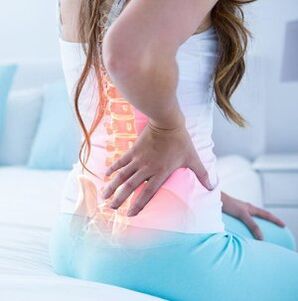Osteochondrosis- This is a complex of violations that occur in the articular cartilage.Mostly in the event of damage to the intervertebral discs, which in most cases are in most cases in most cases the neurological manifestations of osteochondrosis.Osteochondrosis forms between vertebral slices and leads to a significant deterioration in the quality of life of patients who are forced to constantly suffer from unpleasant symptoms.Manifestations of osteochondrosis are numerous, mainly from regular repeated pain in the neck, in the back, in the headache, in dizziness, for the sound of the ears, in numbness in different parts of the body and other unpleasant symptoms.
Causes and symptoms of osteochondrosis

Osteochondrosis is widespread due to its special features.It is based on the natural process of biological aging of the body.The intermediate tasting disc loses its safety function over time.There is a narrowing of the intermediate slot, and the radicular nerves and blood vessels are clamped in it.This leads to severe pain, an impaired motor function, headache and other symptoms.
Among other things, the causes of this disease can be mentioned:
- sitting, sitting lifestyle;
- Excessive loads (lifting objects with a large mass, physical overload);
- Autoimmune processes in the body (e.g. red lupus, systemic scleroderma and other similar diseases);
- Metabolic disorders with a critical body weight;
- Calcium balance diseases in the body;
- Pregnancy (provokes osteochondrosis in women due to the impoverishment of the body with calcium and an inadequate distribution of increasing body weight compared to the vertical axis);
- Spinal injuries.
The impressive complication of osteochondrosis is the formedA hernia of the intervertebral discThis can require surgical intervention.Depending on the degree of complications, the symptoms from mild to high severity can vary.
Neurological manifestations of osteochondrosis are most common factors that lead to a restriction of human disability.
TOThe main symptomsThe following can be attributed:
- Pain in different parts of the spine;
- Violations of organs, which are innovated by the nerves of the affected area of the spine (for example, affects the secretion and peristalsis with thoracic osteochondrosis);
- Different types of vegetative disorders (violation of sweating, trophism or nutrition of tissues, skin temperature, etc.);
- Headache and dizziness;
- Violations and loss of tendon reflexes (muscle) reflexes (they can increase, reduced, uneven or not mentioned).In each individual segment of the spine and other departments of the musculoskeletal system, specifically (only inherent in this department), signs of violations.
So withcervical osteochondrosisHeadaches are noticed that during the neck change, dizziness, flickering of "flying" in the eyes, fainting, etc.Lumbale osteochondrosis- Acute pain ("shots") in the back and lower, deafness of the legs, violations in the work of the genitarian organs.
Osteochondrosis is often confused with other diseases with similar symptoms, i.e.Only a qualified neurologist can determine a precise diagnosisAfter she spoke to the patient and carried out objective research.
The timely search for a doctor avoids the development of complications!
Diagnostic and treatment methods
Modern instrumental methods are used to diagnose osteochondrosis:
- Magnetic resonance imaging (enables you to get pictures of the entire field of interest and to identify the exact focus of the developed pathology).
- Computed tomography with the visualization of bone cheese structures and soft tissues;
- X rays to determine the mutual arrangement of repressed vertebrae and the axis of their shift.
Depending on the results of the diagnosis, the causes and characteristic syndromes with which osteochondrosis is carried out are also selected.
The course of treatment is quite long.In order to achieve persistent results, he must include:
- Restriction of mobility in the acute period;
- Drug treatment;
- Massage;
- Manual therapy after rejecting the deterioration.
For recovery after the disease, methods such asHirudotherapy(Treatment with leeches), physiotherapy exercises, massage, thermal interventions.According to the information, it is assignedPhysoizationHowever, this method has a number of contraindications and requires medical control.In the current stage of the development of medicine, it is possible to achieve continuing remission and significantly reduce the risk of deterioration, provided that all recipes are carried out by the doctor.To prevent the disease, work hygiene should not be observed, not lifted, avoid hypothermia, etc., etc.
























